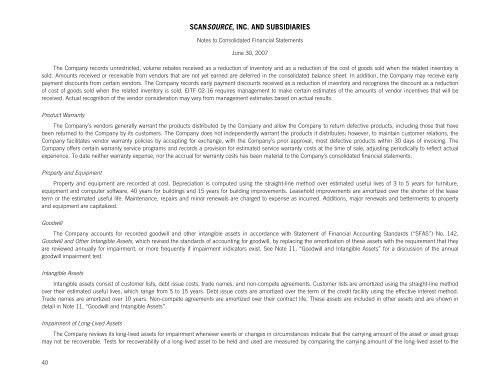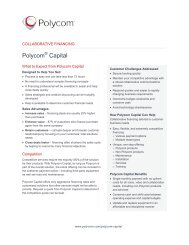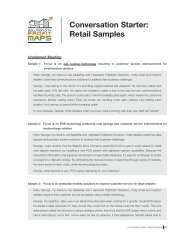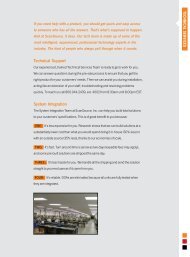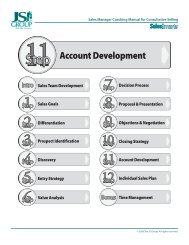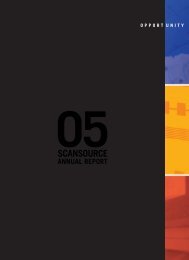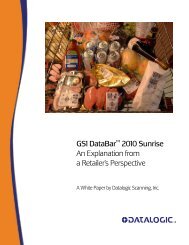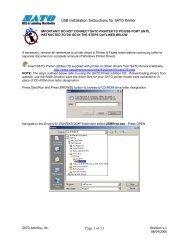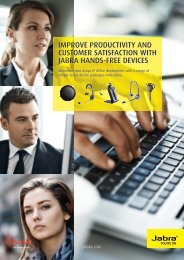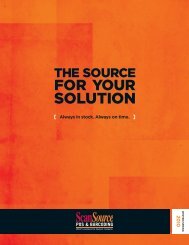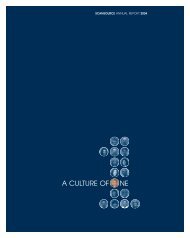Download PDF - ScanSource
Download PDF - ScanSource
Download PDF - ScanSource
You also want an ePaper? Increase the reach of your titles
YUMPU automatically turns print PDFs into web optimized ePapers that Google loves.
SCANSOURCE, INC. AND SUBSIDIARIES<br />
Notes to Consolidated Financial Statements<br />
June 30, 2007<br />
The Company records unrestricted, volume rebates received as a reduction of inventory and as a reduction of the cost of goods sold when the related inventory is<br />
sold. Amounts received or receivable from vendors that are not yet earned are deferred in the consolidated balance sheet. In addition, the Company may receive early<br />
payment discounts from certain vendors. The Company records early payment discounts received as a reduction of inventory and recognizes the discount as a reduction<br />
of cost of goods sold when the related inventory is sold. EITF 02-16 requires management to make certain estimates of the amounts of vendor incentives that will be<br />
received. Actual recognition of the vendor consideration may vary from management estimates based on actual results.<br />
Product Warranty<br />
The Company’s vendors generally warrant the products distributed by the Company and allow the Company to return defective products, including those that have<br />
been returned to the Company by its customers. The Company does not independently warrant the products it distributes; however, to maintain customer relations, the<br />
Company facilitates vendor warranty policies by accepting for exchange, with the Company’s prior approval, most defective products within 30 days of invoicing. The<br />
Company offers certain warranty service programs and records a provision for estimated service warranty costs at the time of sale, adjusting periodically to reflect actual<br />
experience. To date neither warranty expense, nor the accrual for warranty costs has been material to the Company’s consolidated financial statements.<br />
Property and Equipment<br />
Property and equipment are recorded at cost. Depreciation is computed using the straight-line method over estimated useful lives of 3 to 5 years for furniture,<br />
equipment and computer software, 40 years for buildings and 15 years for building improvements. Leasehold improvements are amortized over the shorter of the lease<br />
term or the estimated useful life. Maintenance, repairs and minor renewals are charged to expense as incurred. Additions, major renewals and betterments to property<br />
and equipment are capitalized.<br />
Goodwill<br />
The Company accounts for recorded goodwill and other intangible assets in accordance with Statement of Financial Accounting Standards (“SFAS”) No. 142,<br />
Goodwill and Other Intangible Assets, which revised the standards of accounting for goodwill, by replacing the amortization of these assets with the requirement that they<br />
are reviewed annually for impairment, or more frequently if impairment indicators exist. See Note 11, “Goodwill and Intangible Assets” for a discussion of the annual<br />
goodwill impairment test.<br />
Intangible Assets<br />
Intangible assets consist of customer lists, debt issue costs, trade names, and non-compete agreements. Customer lists are amortized using the straight-line method<br />
over their estimated useful lives, which range from 5 to 15 years. Debt issue costs are amortized over the term of the credit facility using the effective interest method.<br />
Trade names are amortized over 10 years. Non-compete agreements are amortized over their contract life. These assets are included in other assets and are shown in<br />
detail in Note 11, “Goodwill and Intangible Assets”.<br />
Impairment of Long-Lived Assets<br />
The Company reviews its long-lived assets for impairment whenever events or changes in circumstances indicate that the carrying amount of the asset or asset group<br />
may not be recoverable. Tests for recoverability of a long-lived asset to be held and used are measured by comparing the carrying amount of the long-lived asset to the<br />
40


